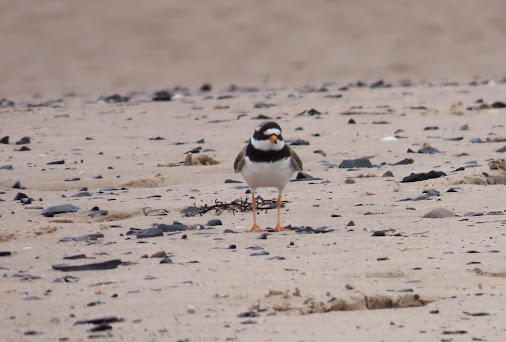Budle Bay, part of the extensive Lindisfarne National Nature reserve, is a large tidal inlet, where expanses of sand are revealed at low tide. I took a short walk along the east side, starting from Waren Mill and heading all the way to Bamburgh. To begin with it was nice and quiet but by the time you get to Bamburgh there were hoards of dog walkers, with their naughty canines off the lead scaring all the birds away, so it was a quiet sort of day, birdwise.
Being an estuary, WADERS are the order of the day, but despite all the glorious amount of mud to feed on, numbers were fairly low. WHIMBREL were pretty numerous, outnumbering the local CURLEWS. These two waders are very similar, at one point an individual of both species stood side by side. The whimbrel is around two thirds the size of a curlew, with a distinctive eye stripe and a bent rather than curved bill. Its the sort of bird that intermediate birders like to get their teeth into, testing the knowledge of the more experienced bird lover. Aside from the other usual species a GREENSHANK was also present. By the way they were acting, a pair of RINGED PLOVER were nesting in a roped off area. The parents feign injury to lead you away from any young that might be nearby, a handy tactic when you nest on a busy beach.
As usual for the area MERGANSERS and EIDERS were around in small numbers. A feature of the Bay is the numbers of TERNS that rest on inaccessible sand banks, while others feed on the sea, but this year the local colonies have been decimated by bird flu, and although there were some birds, numbers were much lower than usual.
Being one of the first summer migrants to reach our shore, SAND MARTINS nest and raise young relatively early in the year, and by mid July are ready to leave again. Despite the atrocious Spring where I barely saw a single bird, they seem to have had a decent breeding season this summer, in Northumbria anyway. Birds were flying all along the coast, looking to brave it out at sea, and many of the birds were roosting on the sandy beach. Its always good to witness first hand the wonders of migration, to marvel at how something so tiny, something that fits into the palm of your hand, can know and be able to migrate to sub Saharan Africa from our shores and back.
Bamburgh with its dominant castle ruling the skyline, was the end route, with nearby set-aside fields full of blue chichory. It was a short walk, with not much of note, but I've decided to include it, just because its not one of the most obvious of choices for a blog on Northumbria. Yes, I've been to better places in Northumbria, but I'll give little Budle Bay a shout, just for the hell of it.





No comments:
Post a Comment